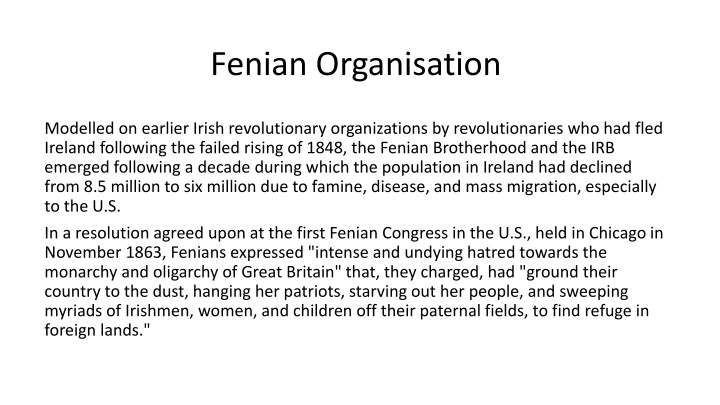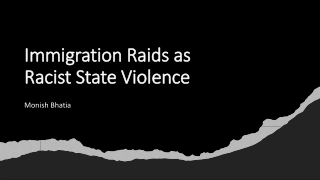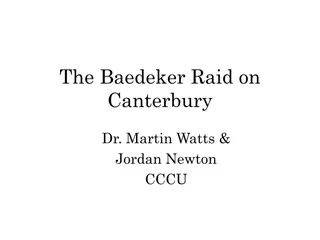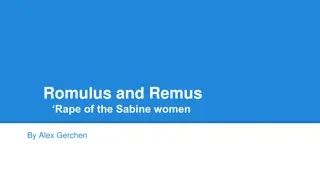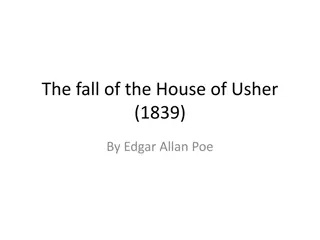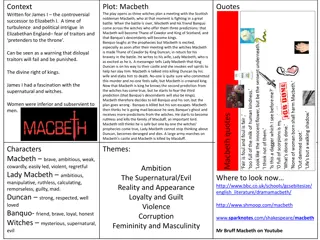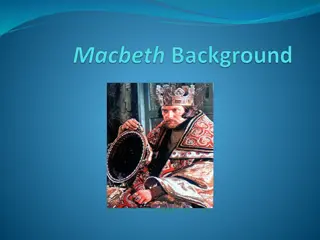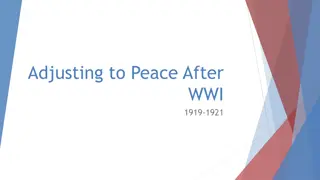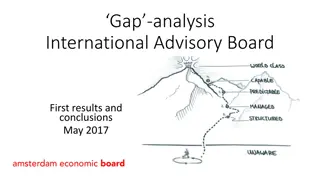The Fenian Brotherhood: Raids, Intrigues, and Ambitions
The Fenian Brotherhood, a revolutionary organization founded by Irish exiles, conducted military incursions into Canada in 1866 as part of their efforts to establish an Irish Republic. Motivated by grievances against British rule and seeking support from Irish-Americans, the Fenians enacted a bold plan of attack involving multiple invasions, sparking tensions between the United States and Great Britain. Despite their ambitions, the Fenians faced challenges and limited support, ultimately falling short of their goals.
Download Presentation

Please find below an Image/Link to download the presentation.
The content on the website is provided AS IS for your information and personal use only. It may not be sold, licensed, or shared on other websites without obtaining consent from the author.If you encounter any issues during the download, it is possible that the publisher has removed the file from their server.
You are allowed to download the files provided on this website for personal or commercial use, subject to the condition that they are used lawfully. All files are the property of their respective owners.
The content on the website is provided AS IS for your information and personal use only. It may not be sold, licensed, or shared on other websites without obtaining consent from the author.
E N D
Presentation Transcript
Fenian Organisation Modelled on earlier Irish revolutionary organizations by revolutionaries who had fled Ireland following the failed rising of 1848, the Fenian Brotherhood and the IRB emerged following a decade during which the population in Ireland had declined from 8.5 million to six million due to famine, disease, and mass migration, especially to the U.S. In a resolution agreed upon at the first Fenian Congress in the U.S., held in Chicago in November 1863, Fenians expressed "intense and undying hatred towards the monarchy and oligarchy of Great Britain" that, they charged, had "ground their country to the dust, hanging her patriots, starving out her people, and sweeping myriads of Irishmen, women, and children off their paternal fields, to find refuge in foreign lands."
Fenian raids on Canada In 1866, the Fenian Brotherhood conducted three military incursions into Canada after plans for an insurrection in Ireland had fallen apart due to British raids against the IRB in Dublin in September 1865 that had resulted in arrests and dispersal of the leadership. With many Irish-American veterans of the American Civil War in their ranks, the Fenians decided to seize territory in British North America and proclaim an Irish Republic. They hoped their raids would encourage the United States to follow with troops in order to establish the St. Lawrence River as its northern border or even to annex the whole of Canada. During the Civil War, tensions had heightened between the U.S. and Great Britain when the latter, after declaring its neutrality in the conflict, allowed Confederate diplomats passage on British ships and sanctioned the building in England of Confederate cruisers that later destroyed Union merchant ships. American hostility to Great Britain increased in October 1864 when a Confederate band, after crossing the Canadian border, robbed banks in St. Albans, Vermont, stole horses, set fire to houses, and shot a citizen before returning to Canada. After a local Canadian court released the raiders on a technicality, voices in the American press called for an invasion.
Plan of Attack The plan of attack, devised by the Fenian secretary of war who had been a U.S. Army major during the Civil War, called for multiple invasions: across the Vermont-Canadian border; from Malone and Potsdam in New York to the Canadian towns of Cornwall and Prescott, then north to Ottawa and Montreal; across Lake Michigan and Lake Huron to Stratford and London in order to gain control of an important railway terminal; and incursions to capture Toronto and major waterway and railway centres. The Fenians had some reason to believe that the U.S. government would recognize an Irish republic on captured British soil, as President Andrew Johnson and his Secretary of State, William Seward, anxious not to antagonize Irish- American voters, reportedly stated that the U.S. would "acknowledge accomplished facts," in the words of historian William D'Arcy, when they were informed by a Fenian delegation about the group's vague intentions to seize territory in Canada. No official U.S. commitment, however, ever was committed to writing.
Across the Border The first Fenian operation of 1866 occurred in April when a small force raided Indian Island in New Brunswick as part of a plan to invade the nearby island of Campobello in order to establish a base for a later landing in Ireland, for launching cruisers to attack British commercial vessels, and as a diversionary tactic designed to keep British troops in North America preoccupied while revolutionaries in Ireland attempted a rising. By declaring themselves a republic at war with Great Britain, the Fenians hoped to attain the status of belligerents, rather than pirates, and thus not risk violating U.S. neutrality laws. A concerted effort by Canadian militias, well-armed British naval vessels, and the American military, however, confounded Fenian plans with only a few shots fired during confrontations and no reported casualties. Some nine combatants from each side were killed in battle, however, during the second Fenian invasion of 1866, which began in the early morning of June 1 as a Fenian force of nearly 1,000 men traveling on canal boats that were towed by tugs crossed the Niagara River near Buffalo and landed at a dock just north of the Canadian village of Fort Erie, which they proceeded to occupy. Two days later, following a victory at Ridgeway over ill-prepared Canadian volunteer forces the ease of disrupting the Campobello plot apparently had led to complacency among Canadian troops the Fenians, aware that a large Canadian force was approaching, retreated back across the Niagara River, where U.S. naval forces belatedly called into action arrested them. Three days later, President Johnson issued a proclamation characterizing the Fenians as "evil-disposed persons" and their actions as "proceedings which constitute a high misdemeanor, forbidden by the laws of the United States as well as by the law of nations." The final Fenian raid in 1866 took place one day after Johnson's proclamation, on June 7, when a band of less than 1,000 raiders starting out from St. Albans crossed the Vermont border and planted an Irish flag near the Canadian village of Pigeon Hill. Fenians subsequently occupied Pigeon Hill and three additional Canadian villages before fleeing from a Canadian cavalry corps that chased them back to the border. Under political pressure during a congressional election year, Johnson issued executive orders to release Fenians arrested in the raids and return arms that were seized, and intervened with British authorities to try to get Fenian prisoners in Canada and Ireland released. Although 25 of the invaders were tried and convicted, all but one a man who died in prison were pardoned by 1872.
Kelly & Chester Castle attack/Manchester Martyrs 1867 There was an attempted uprising in 1867, though it was a failure. The uprising was led by Thomas Kelly who had fought in the American Civil War. Kelly did not base himself in Ireland but in London. Here he gained support from the large Irish community that had come to the city during the Great Famine. Kelly and other Fenians attempted to attack Chester Castle to gain weapons and ammunition. This was not a success and Kelly and another Fenian were arrested. In September 1867, Kelly was being taken to Manchester to be tried when he was rescued by other Fenians. During the rescue, a policeman was killed. Three of the Fenians were caught and after a trial were hanged for murder. To the Fenians, they became known as the Manchester Martyrs . To many in Ireland, the sentence was considered far too harsh for what they saw as an accidental killing.
Fenian impact on British Government The activities of the Fenians were partly responsible for spurring William Gladstone into his stated mission to pacify Ireland . This led to the rise of Home Rule and the issues surrounding it. The Fenian movement became seemingly dormant for a number of decades though it still existed as a movement. The Irish Republican Brotherhood was the most famous of the parts that made up the Fenian movement.
Fenian radicals The Invincibles However, politics now took a role in Ireland s history. The murders of Lord Cavendish and T Burke in Phoenix Park, Dublin, in 1882 showed the government in London that there were elements in Ireland who worked outside of the political arena even while Home Rule was being discussed. This murder was carried out by a group that called itself The Invincibles .
The Phoenix Park murders Arriving in Dublin on 6 May 1882, the Chief Secretary for Ireland, Frederick Cavendish, attended to some formal business in Dublin Castle, the seat of the British government, before walking home to his residence in the Phoenix Park. He was met by permanent Undersecretary Thomas Henry Burke in a cab on Chesterfield Avenue, just inside the park s entrance. Joining Cavendish in his walk, the two men were approached by a group of seven men, three in front, two in the middle and two behind.
Passing through the first three, who turned around, they approached the middle two Joe Brady and Tim Kelly, Brady stabbed Burke while Kelly made for Cavendish both using surgical knives killing the two British officials in what was regarded as a brutal assassination. Afterwards the killers made their way from the park at a hurried pace on two cabs, the first driven by Myles Kavanagh, the second cab driven by James Fitzharris, known better as Skin the goat . In Dublin they would leave a card into all the major newspapers identifying themselves as the Irish National Invincibles.
